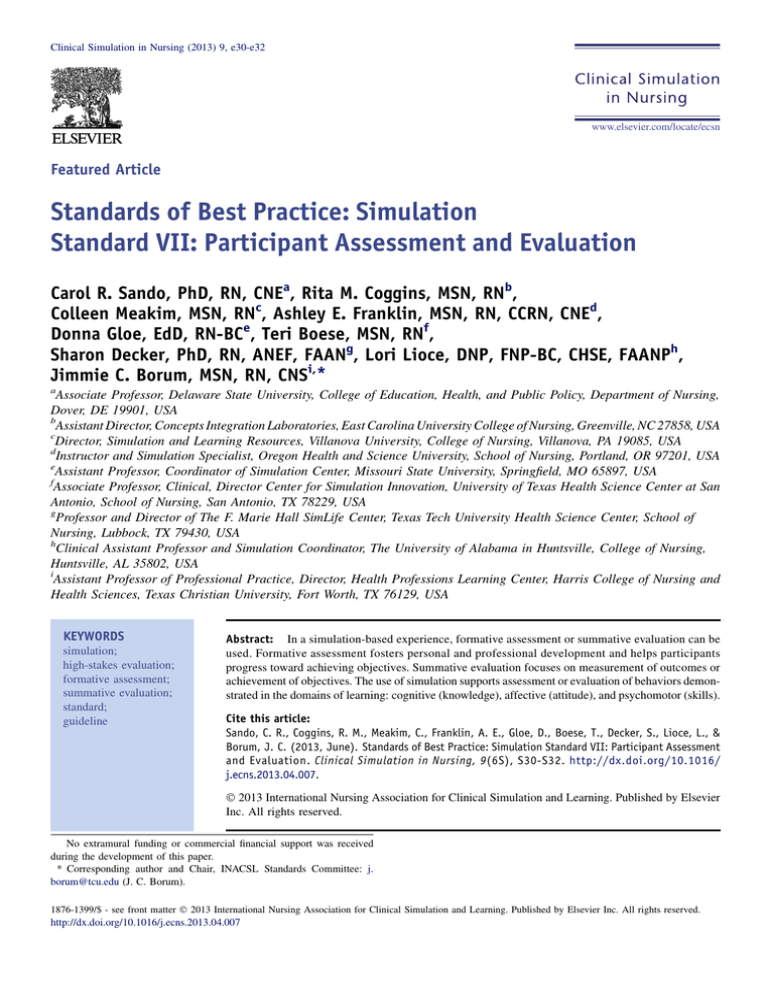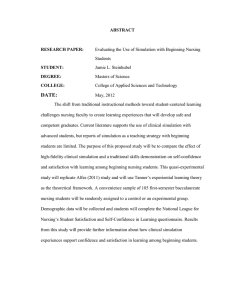
Clinical Simulation in Nursing (2013) 9, e30-e32
www.elsevier.com/locate/ecsn
Featured Article
Standards of Best Practice: Simulation
Standard VII: Participant Assessment and Evaluation
Carol R. Sando, PhD, RN, CNEa, Rita M. Coggins, MSN, RNb,
Colleen Meakim, MSN, RNc, Ashley E. Franklin, MSN, RN, CCRN, CNEd,
Donna Gloe, EdD, RN-BCe, Teri Boese, MSN, RNf,
Sharon Decker, PhD, RN, ANEF, FAANg, Lori Lioce, DNP, FNP-BC, CHSE, FAANPh,
Jimmie C. Borum, MSN, RN, CNSi,*
a
Associate Professor, Delaware State University, College of Education, Health, and Public Policy, Department of Nursing,
Dover, DE 19901, USA
b
Assistant Director, Concepts Integration Laboratories, East Carolina University College of Nursing, Greenville, NC 27858, USA
c
Director, Simulation and Learning Resources, Villanova University, College of Nursing, Villanova, PA 19085, USA
d
Instructor and Simulation Specialist, Oregon Health and Science University, School of Nursing, Portland, OR 97201, USA
e
Assistant Professor, Coordinator of Simulation Center, Missouri State University, Springfield, MO 65897, USA
f
Associate Professor, Clinical, Director Center for Simulation Innovation, University of Texas Health Science Center at San
Antonio, School of Nursing, San Antonio, TX 78229, USA
g
Professor and Director of The F. Marie Hall SimLife Center, Texas Tech University Health Science Center, School of
Nursing, Lubbock, TX 79430, USA
h
Clinical Assistant Professor and Simulation Coordinator, The University of Alabama in Huntsville, College of Nursing,
Huntsville, AL 35802, USA
i
Assistant Professor of Professional Practice, Director, Health Professions Learning Center, Harris College of Nursing and
Health Sciences, Texas Christian University, Fort Worth, TX 76129, USA
KEYWORDS
simulation;
high-stakes evaluation;
formative assessment;
summative evaluation;
standard;
guideline
Abstract: In a simulation-based experience, formative assessment or summative evaluation can be
used. Formative assessment fosters personal and professional development and helps participants
progress toward achieving objectives. Summative evaluation focuses on measurement of outcomes or
achievement of objectives. The use of simulation supports assessment or evaluation of behaviors demonstrated in the domains of learning: cognitive (knowledge), affective (attitude), and psychomotor (skills).
Cite this article:
Sando, C. R., Coggins, R. M., Meakim, C., Franklin, A. E., Gloe, D., Boese, T., Decker, S., Lioce, L., &
Borum, J. C. (2013, June). Standards of Best Practice: Simulation Standard VII: Participant Assessment
and Evaluation. Clinical Simulation in Nursing, 9(6S), S30-S32. http://dx.doi.org/10.1016/
j.ecns.2013.04.007.
Ó 2013 International Nursing Association for Clinical Simulation and Learning. Published by Elsevier
Inc. All rights reserved.
No extramural funding or commercial financial support was received
during the development of this paper.
* Corresponding author and Chair, INACSL Standards Committee: j.
borum@tcu.edu (J. C. Borum).
1876-1399/$ - see front matter Ó 2013 International Nursing Association for Clinical Simulation and Learning. Published by Elsevier Inc. All rights reserved.
http://dx.doi.org/10.1016/j.ecns.2013.04.007
Standard VII: Participant Assessment or Evaluation
S31
Statement
In a simulation-based experience, formative assessment or
summative evaluation can be used.
Rationale
Formative assessment fosters personal and professional development and helps participants progress toward achieving
objectives. Summative evaluation focuses on measurement
of outcomes or achievement of objectives. The use of
simulation supports assessment or evaluation of behaviors
demonstrated in the domains of learning: cognitive (knowledge), affective (attitude), and psychomotor (skills).
Outcome
The outcome of formative assessment is the improvement
of participants’ performance. The outcome of summative
evaluation or high-stakes evaluation may be an assigned
grade, promotion, merit pay, certification, or demonstration
of achievement of objectives or competency.
Criteria
To promote valid and reliable results, determine the type of
participant assessment or evaluation prior to the simulationbased experience. Participant assessment or evaluation may
include:
Formative assessment.
Summative evaluation.
High-stakes evaluation.
Guidelines
Criterion 1: Formative Assessment
Guideline: Formative feedback provides information for
the purpose of improving performance and behaviors
associated with the three domains of learning: cognitive
(knowledge), affective (attitude), and psychomotor (skills).
Guideline Statement: To help participants meet
expected outcomes, formative assessment should be
consistent, providing constructive feedback, such as
coaching, cueing, prompting, or concept mapping.
Formative assessment in simulation should be:
Based on developmental objectives that are designed to
(1) meet participant outcomes, (2) provide feedback,
and (3) remedy errors in thinking and practice.
Accommodating for participants who need extra
learning time.
Appropriate for the level of experience of the
participants.
Specific to provide supplemental strategies for achieving participant outcomes.
Completed in a manner consistent with those described
in Standard VI.
Criterion 2: Summative Evaluation
Guideline: Summative evaluation focuses on measurement
of outcomes or achievement of objectives.
Guideline Statement: Summative evaluation of the
participant’s performance or competence occurs at the
end of a predetermined time period. In some cases, the
evaluation tool may be shared with participants in advance.
Summative evaluation in simulation should be:
Previously tested for evidence-based content.
Based on evaluation tools previously tested with like
populations for validity and reliability; when there is
more than one evaluator, establish interrater reliability.
Standardized in format and in scoring methods.
Accompanied by specific participants’ objectives.
Appropriate in its level of fidelity to achieve participant
outcomes.
Explained before the start of the evaluation process.
Held in an environment with equipment to which the
participant has been oriented.
Based on preestablished guidelines pertaining to participant errors.
Conducted by trained objective observers or raters.
Inclusive of:
i. Guidelines for cueing.
ii. Predetermined parameters for terminating the
scenario before its completion.
iii. Preestablished criteria allowing the evaluator to
rate the participant(s).
iv. Self-assessment by the participant, when this is
a requirement of the simulation-based experience.
Criterion 3: High-Stakes Evaluation
Guideline: Because familiarity with participants is
a significant source of observer bias, the influence of
observers’ previous knowledge of participants should be
avoided whenever possible.
Guideline Statement: Evaluation of participants’ performance by objective observers or raters increases objectivity
and diminishes biased assessment. Moreover, interrater
objectivity and reliability are enhanced by the use of
standardized checklists that focus on assessment of specific
skills. Detailed tools specifically identify appropriate as
well as inappropriate behaviors and help to decrease
subjectivity.
pp S30-S32 Clinical Simulation in Nursing Volume 9 Issue 6S
Standard VII: Participant Assessment or Evaluation
S32
High-stakes evaluation with high-risk consequences
should be:
Explained to participants before the start of the evaluation process.
Pilot tested.
Standardized in format and in scoring methods.
Based on evaluation tools previously tested with
like populations for validity and reliability; when
there is more than one evaluator, establish interrater
reliability.
Conducted at an appropriate level of fidelity to achieve
participant outcomes.
Based on specific participant objectives.
Developed with preestablished guidelines for the type
(if any) of consistent cueing of the participants.
Designed with predetermined parameters for terminating the scenario before its completion.
Designed to include the participant’s self-assessment of
performance as part of the evaluation, when this is a
requirement of the simulation-based experience.
Conducted by trained objective observers or raters.
Original INACSL Standard VII Reference
The INACSL Board of Directors. (2011, August). Standard VII: Evaluation of expected outcomes. Clinical
Simulation in Nursing, 7, s18-s19.
Supporting Materials
Adamson, K. A., Jeffries, P. R., & Rogers, K. J. (2012). Evaluation:
A critical step in simulation practice and research. In P. Jeffries (Ed.),
Simulation in nursing education: From conceptualization to evaluation
(2nd ed.). (pp. 131-161) New York: NLN.
Aschenbrenner, D. S., Milgrom, L. B., & Settles, J. (2012). Designing simulation scenarios to promote learning. In P. R. Jeffries (Ed.), Simulation
in nursing education: From conceptualization to evaluation (2nd ed.).
(pp. 43-74) New York: NLN.
Billings, D., & Halstead, J. (2012). Teaching in nursing: A guide for
faculty (4th ed.). St. Louis: Elsevier.
Block, J. H. (Ed.). (1971). Mastery learning: Theory and practice. New
York: Holt, Rinehart & Winston.
Chesser, A., Cameron, H., Evans, P., Cleland, J., Boursicot, K., &
Mires, G. (2009). Sources of variation in performance on a shared
OSCE station across four UK medical schools. Medical Education,
43, 526-532.
Harasym, P. H., Woloschuk, W., & Cunning, L. (2008). Undesired variance
due to examiner stringency/leniency effect in communication skill
scores assessed in OSCEs. Advances in Health Sciences Education:
Theory and Practice, 13, 617-632.
Humphrey-Murto, S., Smee, S., Touchie, C., Wood, T. J., &
Blackmore, D. E. (2005). A comparison of physician examiners and
trained assessors in a high-stakes OSCE setting. Academic Medicine,
80, S59-S62.
Jefferies, A., Simmons, B., & Regehr, G. (2007). The effect of familiarity
on examiner OSCE scores. Medical Education, 41, 888-891.
Jeffries, P. R., & Rogers, K. J. (2012). Theoretical framework for simulation design. In P. Jeffries (Ed.), Simulation in nursing education: From
conceptualization to evaluation (2nd ed.). (pp. 25-42) New York: NLN.
Kardong-Edgren, S., Adamson, K., & Fitzgerald, C. (2010). A review of
currently published evaluation instruments for human patient simulation. Clinical Simulation in Nursing, 6, e25-e35. http:
//dx.doi.org/10.1016/j.ecns.2009.08.004.
Lasater, K. (2007). High-fidelity simulation and the development of
clinical judgment: Students’ experiences. Journal of Nursing Education,
46, 269-276.
Lie, D., Encinas, J., Stephens, F., & Prislin, M. (2010). Do faculty show the
‘halo effect’ in rating students compared with standardized patients
during a clinical examination? Internet Journal of Family Practice, 8(2).
McCauland, L. L., Curran, C. C., & Cataldi, P. (2004). Use of a human
patient simulator for undergraduate nurse education. International
Journal of Nursing Education Scholarship, 1, 1-17.
Mould, J., White, H., & Gallagher, R. (2011). Evaluation of a critical care
simulation series for undergraduate nursing students. Contemporary
Nurse, 38, 180-190.
Nehring, W. M., & Lashley, F. R. (2010). High-fidelity patient simulation
in nursing education. Boston: Jones and Bartlett.
Prion, S. (2013). Evaluating simulations. Retrieved May 3, 2013, from
http://sirc.nln.org/mod/resource/view.php?id¼99
Rhodes, M., & Curran, C. (2005). Use of the human patient simulator to
teach clinical judgment skills in a baccalaureate nursing program.
Computers, Informatics, Nursing, 23, 256-262.
Smith, S., & Roehrs, C. (2009). High-fidelity simulation: Factors
correlated with nursing student satisfaction and self-confidence. Nursing
Education Perspectives, 30, 74-78.
Stroud, L., Herold, J., Tomlinson, G., & Cavalcanti, R. (2011). Who you
know or what you know? Effect of examiner familiarity with residents
on OSCE scores. Academic Medicine, 86, S8-S11.
Waxman, K. T. (2010). The development of evidence-based clinical
simulation scenarios: Guidelines for nurse educators. Journal of Nursing
Education, 49, 29-35.
Wilkinson, T. J., Frampton, C. M., Thompson-Fawcett, M., & Egan, T.
(2003). Objectivity in objective structured clinical examinations:
Checklists are no substitute for examiner commitment. Academic
Medicine, 78, 219-223.
pp S30-S32 Clinical Simulation in Nursing Volume 9 Issue 6S


